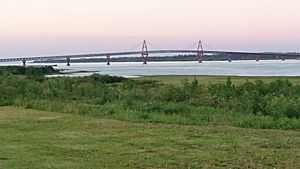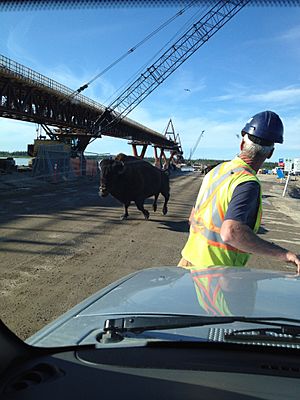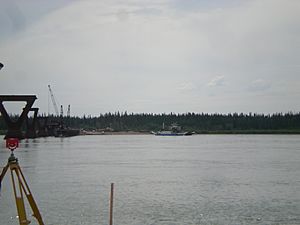Deh Cho Bridge facts for kids
Quick facts for kids Deh Cho Bridge |
|
|---|---|

Deh Cho Bridge 2016
|
|
| Coordinates | 61°15′45″N 117°31′30″W / 61.2625°N 117.525°W |
| Carries | 2 lanes of Highway 3 |
| Crosses | Mackenzie River |
| Locale | Fort Providence |
| Official name | Deh Cho Bridge |
| Owner | Government of the Northwest Territories |
| Characteristics | |
| Design | Truss bridge Cable-stayed main span |
| Total length | 1.1 km (0.68 mi) |
| Longest span | 190 m (623 ft) |
| Number of spans | 9 |
| Piers in water | 8 |
| Design life | 75 years |
| History | |
| Construction begin | June 2008 |
| Construction cost | CA$202 million |
| Opened | November 30, 2012 |
The Deh Cho Bridge is a 1.1 km-long (0.68 mi) cable-stayed bridge that crosses the Mackenzie River in the Northwest Territories. It's part of the Yellowknife Highway (Highway 3) near Fort Providence. The bridge opened on November 30, 2012.
Before the bridge, people crossed the river using a ferry in summer and an ice bridge in winter. The Deh Cho Bridge made travel much easier and safer all year round. The name "Deh Cho" comes from the Slavey language and means Mackenzie River.
Contents
Why Was the Deh Cho Bridge Built?
For many years, people traveling on Highway 3 had to cross the Mackenzie River using a ferry called the MV Merv Hardie. This ferry ran from about mid-May until December or January. When the river froze, an ice road was built across it, which could be used from December to April.
However, there was a problem during spring and fall. In spring, when the ice melted, there was a 3-4 week period when neither the ferry nor the ice road could be used. This meant no vehicles could cross the river. Supplies for Yellowknife and other towns had to be flown in, which was very expensive.
A bridge was needed to make travel easier and to ensure supplies could always reach the communities. Building a bridge was a big project because of the river's size and the cost.
How the Bridge Project Started
After many talks, the Government of the Northwest Territories (GNWT) decided to build the bridge. In 2007, they made an agreement with a group called the Deh Cho Bridge Corporation (DCBC). This group was supposed to help manage the project.
However, things changed later. In 2010, the DCBC had financial problems. The GNWT then took over the project completely. This meant the government became fully responsible for building and managing the bridge.
Who Pays to Cross the Bridge?
The Deh Cho Bridge has tolls, but not for everyone. Only large commercial vehicles, like big trucks weighing over 4,500 kg (9,900 lb), pay a fee. Regular cars and private vehicles do not pay any tolls.
The cost for trucks depends on how many axles they have. For example, in 2016, a truck with 2 to 4 axles paid $78. Larger trucks with 9 or more axles paid $380. These fees help cover the costs of building and maintaining the bridge.
What Does the Deh Cho Bridge Look Like?
The Deh Cho Bridge is a special type of bridge called a truss bridge with a cable-stayed main section. It has nine sections, or spans, that connect to make its total length of 1,045 m (3,428 ft). The main part of the bridge, supported by cables, is 190 m (623 ft) long.
The bridge is built using a special type of steel called weathering steel. This steel changes color over time and doesn't need to be painted. This helps save money on maintenance and makes the bridge last longer. The bridge also has minimal lighting to help drivers see better at night and to protect birds that fly by.
Checking the Cables
The cables that hold up the main part of the bridge are very important. Engineers use special tools, like laser vibrometers, to check the cables regularly. These tools can measure how much the cables vibrate.
By checking the vibrations, engineers can tell if the cables are still strong and have the right tension. This helps them find any problems early, like damage from extreme weather or earthquakes. Keeping the cables in good shape ensures the bridge stays safe for a long time.
How Much Did the Bridge Cost?
The Deh Cho Bridge was a very expensive project. The first plan estimated the cost at $169 million. Most of this money came from special bonds that would be paid back over 35 years.
However, during construction, there were many problems and delays. This caused the cost to go up. By the time the bridge was finished, the total cost had reached about $202 million. This amount does not include some extra costs, like building toll booths or fixing earlier construction issues.
The government now spends about $9 million each year to pay back the loans, collect tolls, and maintain the bridge. They also save about $3 million a year because they no longer need to run the ferry.
Challenges During Construction
Building the Deh Cho Bridge was not easy. Construction started in June 2008, and it was supposed to open in late 2010. However, there were many delays.
Design Problems and Delays
One of the biggest problems was with the bridge's design. Engineers found some issues with the plans for the main part of the bridge. This meant the design had to be changed, which caused delays. The opening date was pushed back to late 2011.
Changing Contractors
The first main construction company, Atcon Construction, had problems. In late 2009, their contract was ended. Another company, Ruskin Construction, took over as the new main builder.
The GNWT also had to take full control of the project in 2010. This meant the government became responsible for all the costs and managing the construction. The NWT Legislature (the government's law-making body) even held a special meeting to discuss the bridge and approve the extra money needed.
More Delays and Costs
Even with a new contractor, there were more delays. Steel parts for the bridge arrived late in 2010. This meant that some parts of the bridge couldn't be finished until the weather was warmer in the spring. The completion date was moved again, to late 2012. These delays added another $10 million to the cost.
In June 2012, even more money was needed to speed up construction and make sure the bridge opened on time in November. This brought the total construction cost to $202 million.
Important Reports About the Project
After the GNWT took over the project, they asked for reports to understand what went wrong and how to fix it.
Auditor General's Report
The Auditor General of Canada, who checks how the government spends money, looked into the bridge project. Their report in 2011 found some key things:
- The project was not a true partnership where risks were shared. The government ended up taking most of the risks.
- Construction started even though the design wasn't fully ready. This increased the chances of problems.
- There was a risk that the project would be delayed and cost more money than planned.
Bridge Wins an Award
Despite all the challenges, the Deh Cho Bridge won an important award in 2013. It received the Gustav Lindenthal Medal from the International Bridge Conference. This award is given to bridges that show harmony with the environment, look good, and involve the community.
The award recognized the bridge for its smart design, which helped it overcome tough challenges like the weather and location. It also praised the bridge for becoming an important landmark.
Images for kids





